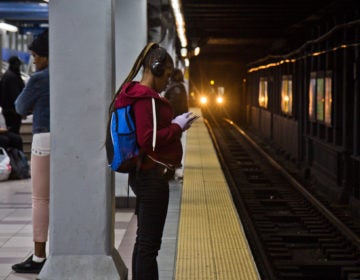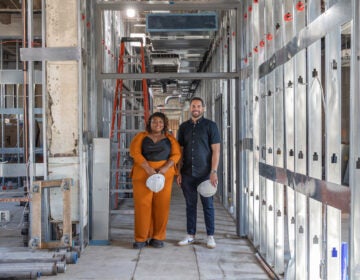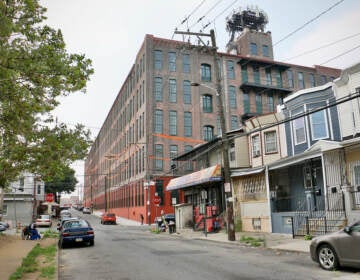City Planning Commission rejects plans for affordable housing on ‘very small lots’
Asociación Puertorriqueños en Marcha and Scannapieco Development Corporation want to build small, two-family rowhomes on vacant city-owned lots.
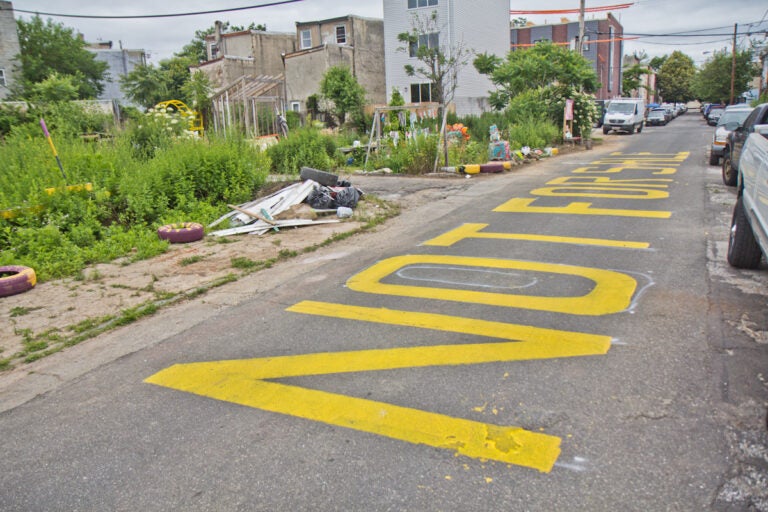
At the César Andreu Iglesias Community Garden in Kensington, the words “Not for sale” were painted on the street as a message to developers and the city in June 2020. (Kimberly Paynter/WHYY)
An attempt to build 40 two-family rowhouses on vacant South Kensington lots and redevelop a former scrap yard into a luxury condo building has suffered a new setback.
The proposal for the North American Street corridor is part of a set of two rezoning bills introduced by Councilmember María Quiñones-Sánchez in June. The second bill creates an overlay on the street between Oxford Street and Lehigh Avenue to allow residential use in what’s currently an industrial corridor designed to be a job center.
Quiñones-Sánchez calls the legislative package “the most aggressive affordable legislation on the books” because they require developers have at least 20% affordable units.
Yet some longtime Latino and Black working-class residents have opposed the bills arguing they won’t be able to afford the housing promised by the projects, and that they will lose job opportunities and open space in the area. Community gardens that have been tended by neighbors for years occupy some of the vacant lots earmarked for rowhouses.
“People in our community, they can’t pay like $1,000 and something for an apartment,” resident Valerie Banks told the Philadelphia Planning Commission at a hearing held Tuesday. “That’s not low-income for us.”
On Tuesday, commissioners approved the bill that would allow multi-family residential units on the N. American Street industrial corridor, but unanimously rejected the measure to use vacant lots currently in the hands of the Land Bank to create mixed-income housing and a condo in the former scrap yard.
The commission voted down the project — to be developed through a public-private partnership with Asociación Puertorriqueños en Marcha and Scannapieco Development Corporation — after city planners challenged its affordable housing specifications and open space plans. The Planning Commission plays an advisory role in city government, providing recommendations that legislators are free to act on— or ignore, as they often do.
The APM and Scannapieco project would put two-family units in tiny 550 square feet lots. While project advocates cheer the density as an innovative way to create affordability in a desirable part of the city, Planning Commission staff planner David Fecteau questioned the plans.
He said the precedent could open a door for other developers who are not offering affordable housing to argue that it is possible to build two-units buildings in such tiny spaces. According to zoning law, lots for new residential multi-family units (RM-1) have to be 1,440 square feet.
“Now we’re saying yes to very small lots,” Fecteau told the commission. “You’re going to have to have a creative architect, I’ll put it that way.”
Quiñones-Sánchez rejected the commission’s contention that the affordability requirements for the overlay aren’t clear but said she would work with the city agency and community to make changes as needed.
The longtime advocate of mixed-income, inclusionary development said the overlay requires at least 20% on-site affordability at no greater than 60% Area Median Income for rental units and 80% AMI for owner-occupied units for the multi-family condo to be developed on North American Street. In addition, at least 1 of 2 units in the two-family buildings to be developed in the rest of the area would be affordable under the plan, she said.
“We are open to community recommendations and our intent is to vote on the bills when we return in September,” Quiñones-Sánchez said in an email. “These bills represent the most aggressive affordable housing legislation on the books. The public private partnership with APM is also a possible model for development.”
Philadelphia is currently in the midst of an unprecedented housing crisis as economic insecurity wrought by the pandemic worsens a long-simmering affordability problem. On the same day as the City Planning Commission hearing, Mayor Jim Kenney found himself negotiating with activists over encampments of people experiencing homelessness. Among other things, Kenney has vowed to experiment with tiny houses built on small lots.
Rose Gray, APM’s senior vice president for community and economic development, said the development represents the nonprofit’s commitment to meeting the city’s urgent housing needs.
“We strongly support affordable housing in this area,” Gray said. “There is, as everyone has stated, and as we can see what’s happening within our city, an extreme need to provide not only rental, but also homeownership opportunities for people to gain wealth and build quality of life and sustain our communities.”
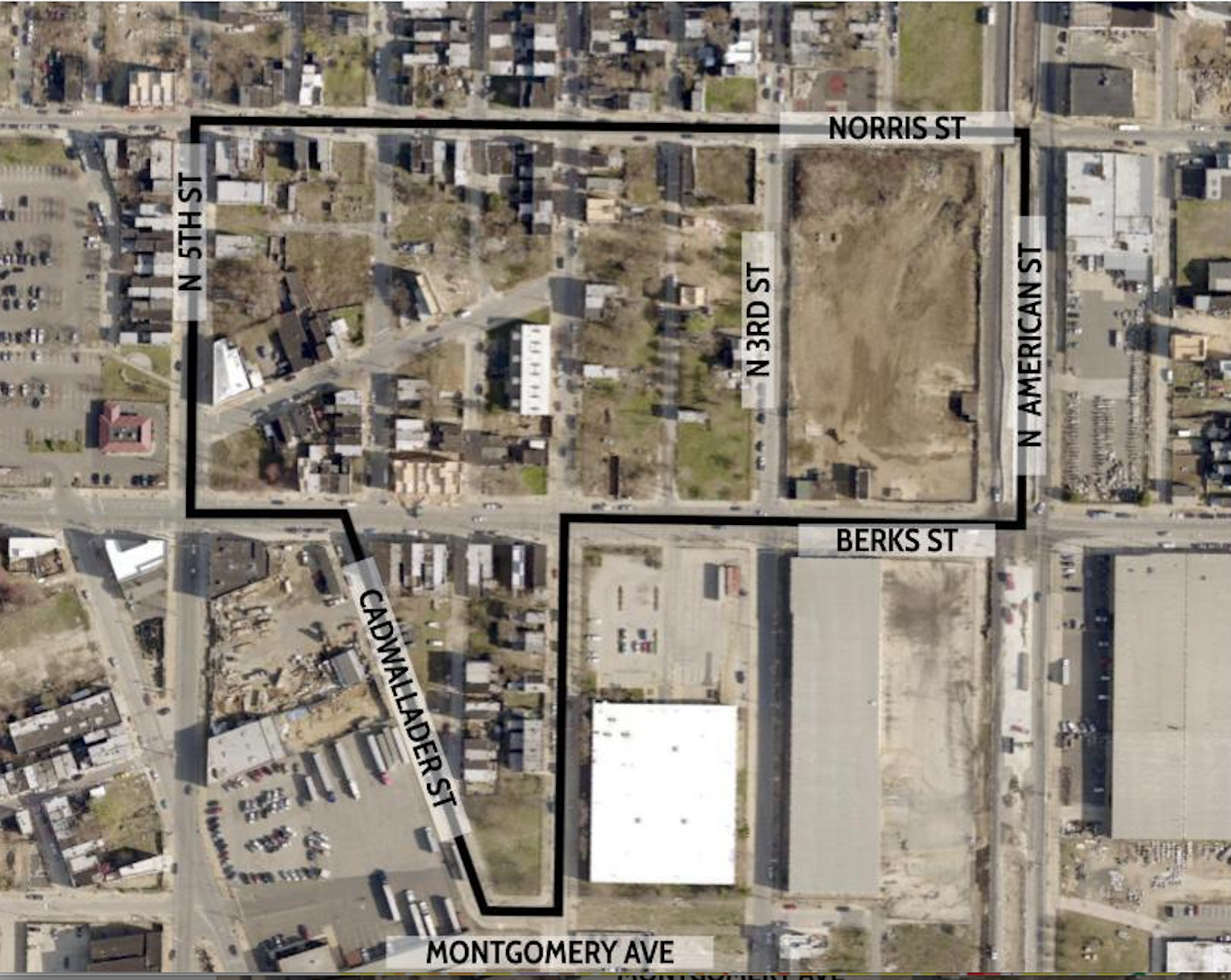

Subscribe to PlanPhilly
Industrial space to become housing
City leaders have long wanted to see North American Street from Girard Avenue to Indiana Avenue in North Philadelphia thrive as a job-generating industrial corridor. Several plans and reports recommend for the land to continue as a destination for manufacturing and production, not the residential development that has transformed formerly industrial areas across the city.
Currently, the area between Oxford Street and Lehigh Avenue, included in the proposed overlay zone, holds 684,000 square feet of business space and the companies located there — Philadabundance, Drexel Foods, Chase’s Foods, American Metal Moulding, NextFab, among others — employ about 230 people.
The overlay will allow multiple-family residential units and commercial space, contradicting previous plans, but aligning with a citywide vision that calls for a mix of housing types, Fecteau, the commission planner, said.
Rising land values in the area and a complete redesign of the corridor which includes bike lanes and stormwater infrastructure in the works, have contributed to increasing development pressure.
“There’s always been a desire by some folks for residential, but I think there’s also continued to be a desire for some type of business development too. So trying to thread that needle has not always been easy,” Fecteau said.
According to the planner’s presentation, the city has already received proposals for review that include about 400 apartments, and that he expects potential submission for another 400 to 600 housing units. Since the overlay has a requirement for at least 20% of affordable units, that could mean 200 to 100 affordable units for the area.
In terms of business development, Fecteau said he would expect to see something similar to what’s being developed in nearby areas — fitness studios, pet grooming and supplies stores, tanning salons, real estate offices, fast food restaurants or even a Target. But the existing industrial enterprises would probably disappear.
“We have no example of any North American city where large apartment buildings were introduced into industrial districts and the businesses stayed,” Fecteau said.
Longtime resident Lisa Maiello, a member of South Kensington Community Partners, a nonprofit organization in South Kensington, said many of those industries were planning to leave anyway and that the overlay would not represent a loss of jobs.
Maiello said the conflicting visions for North American Street over the years have negatively impacted the way that the neighborhood has developed.
“So to the extent that this is a step towards a vision for American street as a whole, I think that’s really great,” she said. “We’re largely in support of the legislation, largely in step with the other community organizations that would like to see deeper affordability, and we also have an interest in making sure that there’s viable commercial space and affordable commercial if that’s possible.”
Planning commissioner Maria González, president of the Latino nonprofit HACE, said even though the corridor has been set aside for industrial and light industrial uses for decades, not much has materialized in the last 10 years. And now that there is so much interest from developers in the area, it is important to make sure that the community benefits.
“Having a decent percentage of 20% set aside for affordable is really critical to make sure that we have affordable housing in the neighborhood and there is no displacement of people from the community and they’re able to enjoy the new developments in the area,” she said.
‘Gentrification is not the key’
Both bills were put on hold by the city commission in June because of a lack of community input. But after planners promised to talk with neighbors who challenged the project, City Council’s Rules Committee voted to advance the bills. They are now slated to go to full City Council for a vote in September.
Adam Butler, a representative of the César Andreu Iglesias Community Garden located in the area, said even though the planning commission’s decision is non-binding, he appreciates the Commission’s acknowledgment of the bill’s problems.
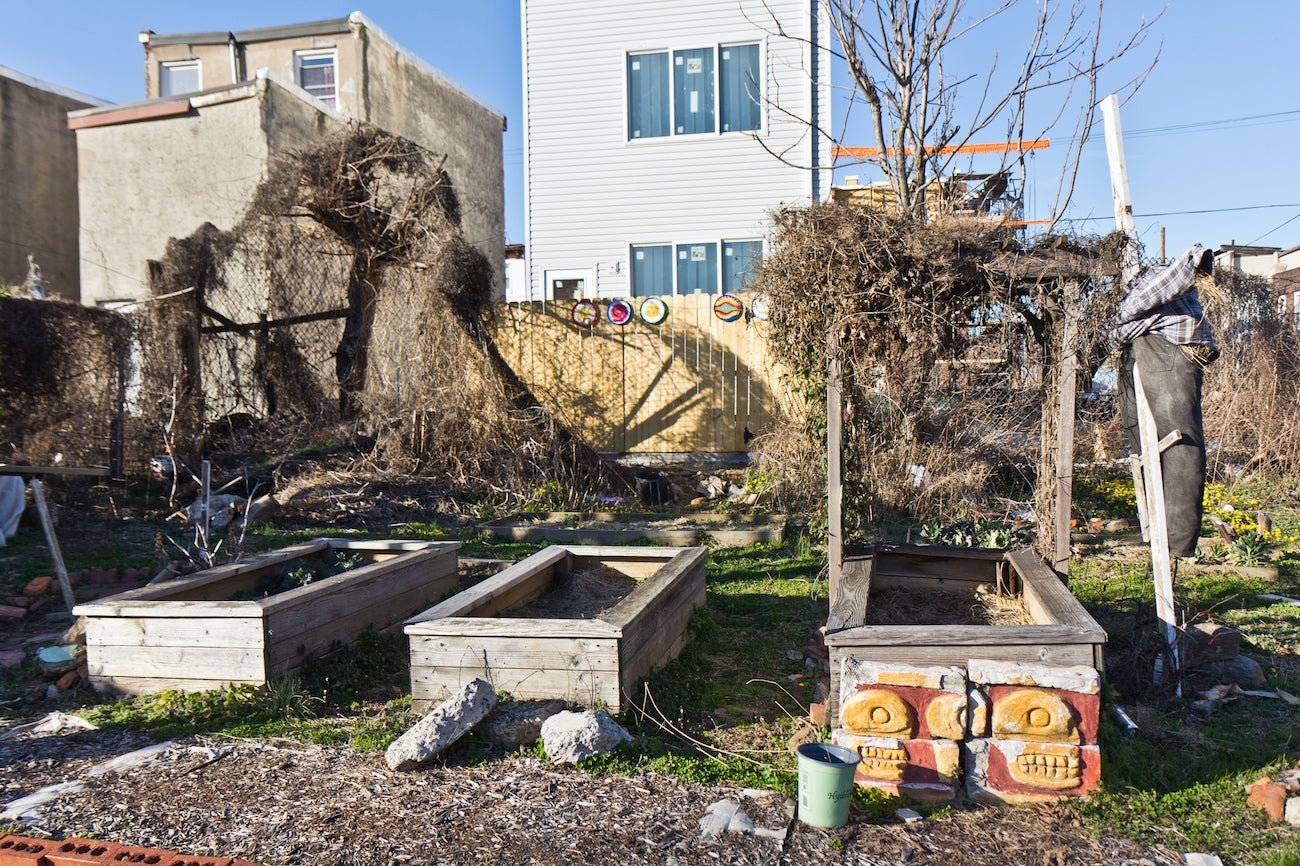
To him, the special arrangements for the huge lot on North American Street, the former scrap yard, feel a lot like spot zoning. And that the APM and Scannapieco development, even with 60% AMI affordability, would not benefit the people living there.
The overlays also eliminate the requirements for developers to create open space in all of the lots, including the lot used by the scrapyard which is located on the entire block bounded by Norris Street, American Street, Berks Street, and Third Street. Under city zoning laws, the site requires open space, but city planner Fecteau said APM and Scannapieco asked for an exemption.
“I think it’s because of the contamination on the site. Other developers have figured that out, how to remediate the site and leave an open space. I don’t know what these folks are thinking, but they requested these carve-outs for their development,” Fecteau said.
In March, garden members and residents stopped a Land Bank proposal to lease 58 vacant lots on about four city blocks between West Norris and Berks streets, 3rd and 4th streets to APM for five years. Many of them have been tended as gardens and patios for decades by residents. Since then, Angel Rodríguez — the Land Bank’s current executive director, and APM’s former vice president — has transferred property of some lots to the community garden and is working with the community. They’ll meet for discussions on Aug. 25.
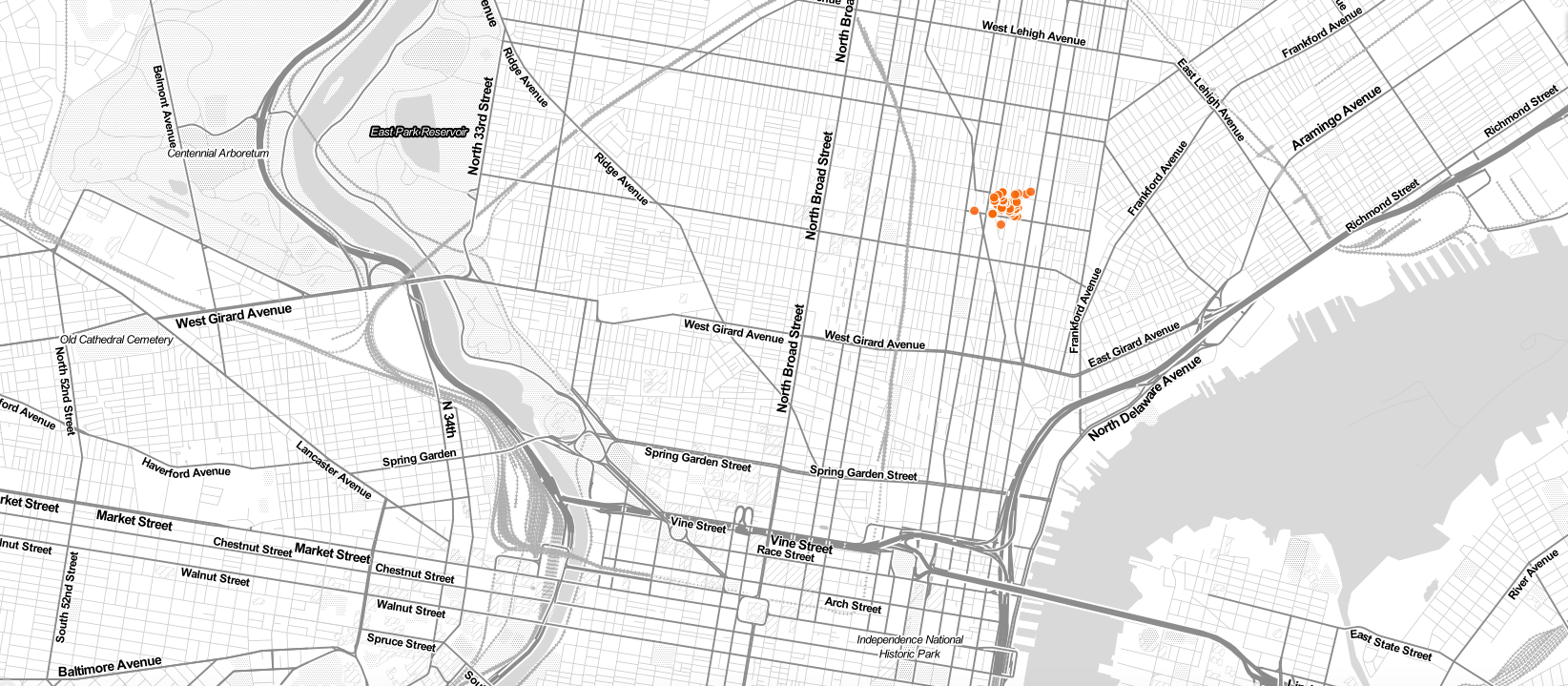
Councilmember Quiñones-Sánchez had said the bills have to be approved by the end of the year as a way to guarantee affordable housing in her district, which is seeing growing pressure from developers trying to build there before the 10-year tax abatement is reduced. Developers have advanced plans for thousands of new housing units as they rush to get approvals before the abatement changes in the new year.
Butler disagrees and hopes City Council rejects the bill and works with neighbors.
“Speeding these bills through this process, with the limited amount of community engagement, a tremendous number of questions outstanding, and a lot of items just unaccounted for in terms of what will be happening here, does not feel right,” he said.
Resident Leslie Gonza said what the community needs is employment, food, and housing options they can actually afford.
“Gentrification is not the key to end all financial hardship in our city,” she said in an email.
WHYY is your source for fact-based, in-depth journalism and information. As a nonprofit organization, we rely on financial support from readers like you. Please give today.



